
 |
|
|
Please write: dan@dancooper.tv
Return to Page One
Register here to receive Fashion Finds
email updates!

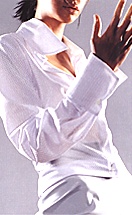 |
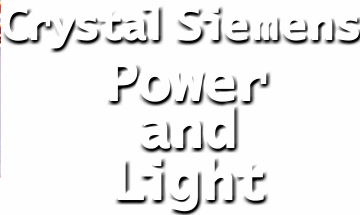 |
Crystal was born on a farm in rural Saskatchewan, a huge expanse
of golden prairie in central Canada.
 |
One of five children, Crystal recalls how the beauty of her childhood surroundings contributed to her aesthetic vision. Her mother, a schoolteacher, sewed and made clothes for Crystal and her siblings, and eventually Crystal learned to sew and design herself.
Crystal began as an economics major in college, but her impulse "to make something do something," and the desire to work with her hands, prompted her to change course and obtain a degree in fashion design. She was on her way. The influence of her surroundings, her travels to other countries, exposure to other cultures, art, architecture, and how people "tick," all contribute to the beauty of her creations.
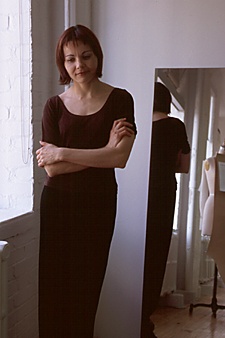 Crystal Siemens in her studio. |
Crystal Siemens: Spring 99, I guess the inspiration there was really about light and how it plays off fabrics. Different fabrics with different textures.
For example, the whole collection is white. And I chose that because I wanted a challenge. Because I wanted to see if you could make an all white collection with that many pieces and still make it look day. Because, you know, all white tends to look more evening.
So the challenge was really coming up with
fabrics that would really work together, and all the different varieties of white that
there are. Because it went anywhere from eggshell to a little bit more of a creamy color
to, you know, stark white. And I was mixing cool with warm colors. And textures: I used
perforated lamb, which was very soft, and unlined jackets and skirts with asymmetric
cutting, and wide border hems, and three quarter length sleeves, and that sort of thing.
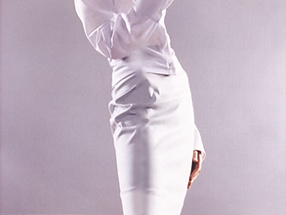 |
FF: Yeah, that’s a really clever idea.
Crystal Siemens: Then a couple of other fabrics I used were, this taffeta, which has a really nice high tech finish on it, and it had 48 percent lycra in it. And what we did was, all the pieces -- dresses, skirts, were folded hems, not pressed, so they were very rounded and almost ballooney in a way. But the silhouettes were very structured and very close to the body. But then you’ve got this hem that was kind of very soft.
And I used contrasting linings such as red or black or nude or blue that went underneath in the same fabric. And what it did, it created borders at the bottoms of these pieces, and you would just get a hint of blue coming through, and a hint of red. It was very, very subtle. The whole collection was about very subtle details. A lot of the seams were skewed to the front and the back, and a lot of cutouts in the linings so that on the hanger you wouldn’t see it, but if you were walking down the street, the skewed side seam would come around to the front; it would be on a diagonal. And when you walked, the lining would open up because it would be slit, and you’d see a bit of the leg through it.
FF: Cool
Crystal Siemens: And then the other fabric I
used in great detail was a really fine high density linen from England. It had a bit of a
glaze finish on it; beautiful, beautiful, very soft white. And I did jackets out of this
and pants. The jackets were all lined with cotton terry. No shoulder pads, nothing -- no
interlinings, no fusings. It was really working with the properties of the two fabrics,
structurally together to complete a garment.
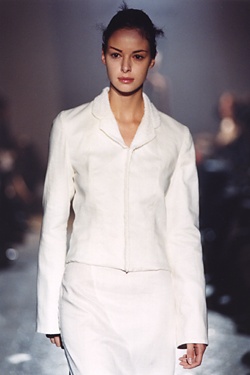 |
So normally when you do a jacket and stuff like that, you put fusing in and all these things on the inside to make it stand up and take shape around the body. But this was just working and finding the fabrics that had the same shrinkage, and worked together to create the structure.
And also, in the jackets what we did was velcro closure, so that the two met in the front and it kind of created more of a three dimensional stand in the front. So the jackets were all very clean and very flat on the body.
Then the pants were generally half lined with white lining so it was more -- the lining was more like a Bermuda short. And then the pants being long.
FF: Right, right. And when you decided that the spring line was going to be about how light plays off the fabrics, how did that idea or theme come to you?
Crystal Siemens: Well, I think because one of my
favorite architects is Tadao Ando.
 |
Editor's Note: Born and raised in Osaka Japan, self-taught architect Tadao Ando has garnered many architectural prizes. He designs buildings primarily in Japan, but has recently branched out to Europe and the United States (where he is currently working on two large projects). Nature is an important component of Ando's work, and often his structures weave together and play with indoor and outdoor space. "To simplify things just for the sake of simplification is easy," says Ando. "My way is to try and make life richer by simplifying things." |
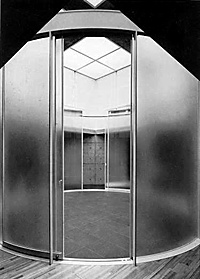 |
And I love what he does, because he really works with different mediums for buildings that are in contrast to one another, and he can work with very tough things like concrete, but bring in the element of nature to create the design, i.e., like a slit in the wall where the sun passes through, and it lights the wall across the way, and it becomes part of art, and architecture.
And similar thinking in the clothing I was doing for spring was the slit that I talked about before in the lining, very, very subtle. Like how would the light affect that if it was coming through this semi-sheer fabric? You know as you’re walking. How does it fold? How does it create gray areas so you’ve got the white fabric but you’re really dealing with a lot more colors.
FF: Yes, absolutely. It’s funny, you know, after I met you a couple of months ago, I was going through some magazine and there was an article about Ando ...
Crystal Siemens: Oh really ...
FF: ... there were some beautiful pictures of some buildings that have already been done, and others that are in progress. And is there any one in particular, or one or two of his buildings that particularly impacted on you or inspired you?
Crystal Siemens: I don’t know them by name. There’s a particular house he did that I really love. Like I couldn’t even pinpoint it for you.
FF: Is this house in Canada or ...
Crystal Siemens: No, no, no, no. Actually I don’t even know where it is. I’ve just seen many ...
FF: Pictures of it...
Crystal Siemens: Also a church that he did. I
think it’s called Church on the Water.
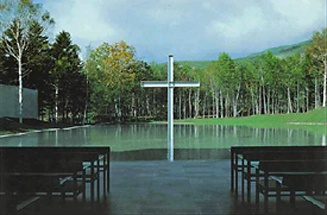 |
And it’s interesting, because I’m not really a -- although I grew up -- with a religious background, I’m not -- I don’t really practice it today. But it’s really interesting when I saw this church, I just thought how inspiring it was. And you should see if you can take a look at a photo. The views all face out; it’s where the preacher stands. And at the end of that wall behind the priest or minister or whatever, it’s a big glass picture window; the whole end of the building. And then there’s a pond out there. And it’s very square and it has a cross in the middle. And just the vista is so amazing.
And I just thought if I was there in that church, and listening to this person talking, and seeing that, I think it would be very moving. I was very moved by it. And it doesn’t matter whether it was a church or a house or whatever it was; it was just an incredibly moving space. And I thought that was really interesting; very spiritual.